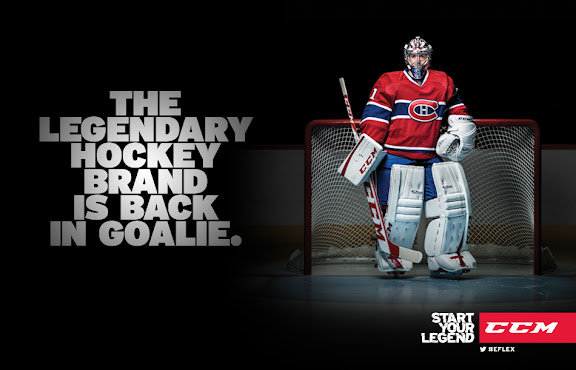So What Happened After '83? (Part 2)
In April 2004 Massachusetts-based running shoe giant Reebok International Ltd. agreed to pay $204 million in cash and assume $125 million in debt in a deal to acquire The Hockey Company, the company which had evolved from the sporting goods division of CCM. In the year prior to the deal, The Hockey Company had reported revenues of $239.9 million and sales in 45 countries. The acquisition was meant to complement Reebok’s successful apparel business which supplied uniforms for the National Football League and the National Basketball Association. It also enabled Reebok to double the market share of its nearest competitor Nike and its Bauer subsidiary.
In 2005 the newly-formed Reebok-CCM Hockey Inc., the world's largest designer, manufacturer and marketer of hockey equipment, launched its new line of Rbk hockey equipment and sticks. To ensure the line gained instant market credibility, the company signed an up-and-coming young star by the name of Sidney Crosby to endorse it.

That same year the company built a massive head office (the size of ten football fields) in Montreal where they employed about 420 of the company's total global staff of nearly 960 workers. The $20-million facility housed a research and design centre, a laboratory, an on-ice field-testing program, product management and development services, a worldwide distribution centre, as well as a marketing department. The centre was also home to a specially-made robot designed to test hockey sticks and a mini cannon that fired pucks at helmets to check their strength.

The new facility in Montreal was to be operated in conjunction with the company's already existing production plants, including that in St. Jean, Quebec, where 120 people were employed making skates and various pieces of hockey equipment, the Cowansville plant where 90 employees produced Rbk and CCM branded hockey sticks and the Saint-Hyacinthe facility where 140 people produced the jerseys worn ny all 30 NHL teams. Meanwhile helmets were made in Edmundston, N.B. where 60 workers were employed. In Europe facilities were located in Finland where 100 people were employed and in Sweden where an additional 116 people were involved in the manufacture of hovkey equipment under the CCM, Jofa and Koho brands. Additional sales offices were located in Toronto and Germany.
In August 2005, it was announced that the Adidas Group of Germany had bought Reebok International for $3.8 billion. Meanwhile the recently launched Reebok-CCM hockey line continued to be endorsed by NHL stars such as Patrick Roy and Martin Brodeur, while the company remained the exclusive licensee of uniforms for the NHL, the Canadian and American hockey leagues, national teams around the world and several National Collegiate Athletic Association teams south of the border.

Despite its size, the picture was far from rosey for the company. In March 2008, Reebok-CCM Hockey Inc. announced it was phasing out its stick-making facility in Cowansville, Que., and transferring production to its plant in St. Jean. It was a move that meant 90 layoffs and had been necessitated, according to the company, by a serious drop in the demand for wooden hockey sticks. The stick-making operation from Drummondville, Que., had already been moved to the St. Jean facility during Christmas of 2002.
"Indeed, players, whether amateur or professional, now overwhelmingly prefer one-piece composite sticks for their lightness and responsiveness, which has resulted in an approximately 30-per-cent decline in demand for wood sticks in North America since 2004," said Dany Paradis, vice-president of human resources and continuous improvement at the time. (Montreal Gazette, Feb. 9, 2008)
At the same time the Adidas Group announced that 83% of its total apparel volume was now being sourced from Asia, with another 12% from Europe. North America accounted for only 5% and most of that came from Canton Massachusetts.
By now 75% of the company’s hockey equipment was also being sourced from Asia. In 2010 after four years of making hockey helmets and plastic components in the Maritimes, the company closed its operation in Edmundston, New Brunswick, abolishing 40 jobs.
Then in November 2011 came the worse news yet for the company's North American workers. It was announced that 85 of the 120 employees at the St. Jean plant would be losing their jobs because of the continued outsourcing of production to Asia.
"Our competitors all manufacture their products in Asia,” said René Habel, vice president of operations Reebok CCM Hockey. “This is what led us to consider the transfer of our activities in countries where costs are lower."
For the workers it was an all too familiar refrain. Although Reebok-CCM tried to indicate its long term commitment to stay in Quebec, the writing was both on the wall.
Another strategic priority for Reebok-CCM Hockey is to continue to pursue a movement away from own manufacturing to sourcing goods. In 2011, for example, the transfer of helmet production from North America to China was finalised, and the transfer of high-end skates production from Canada to Thailand in 2012 was also announced. Manufacturing activities will be maintained mainly to develop and manufacture performance products for pro level athletes.
(Adidas Group 2011 Annual Report)
Although Reebok-CCM Hockey is currently working hard to capitalize on the legendary history of the CCM name, it is a bittersweet turn of events, for the fact remains that in Canada the brand now exists in name only. Nothing that carries the familiar three letters is made anywhere in the country.




